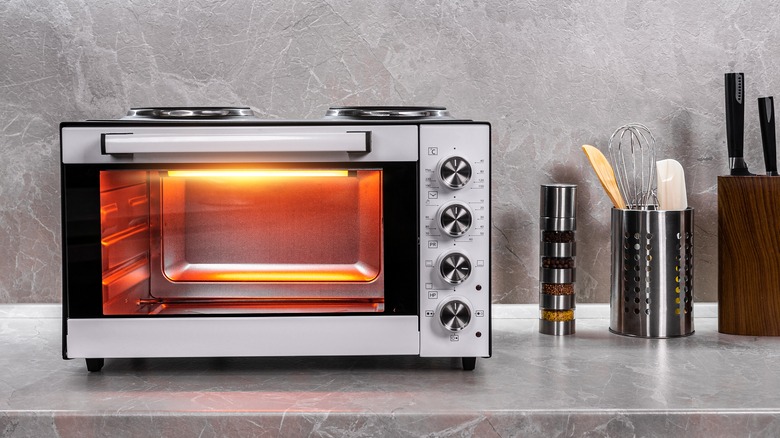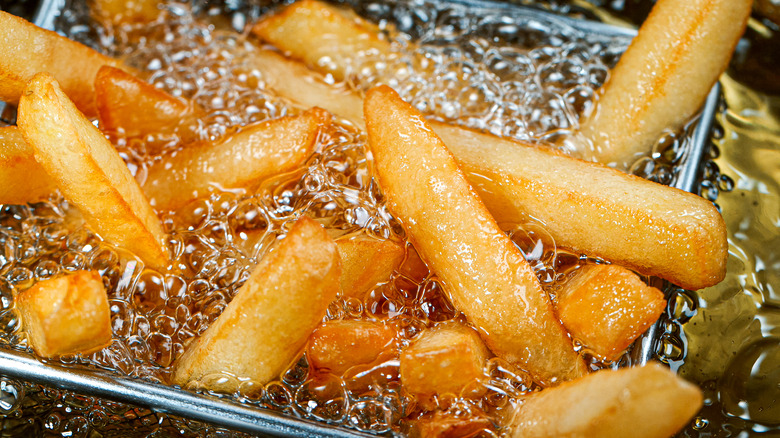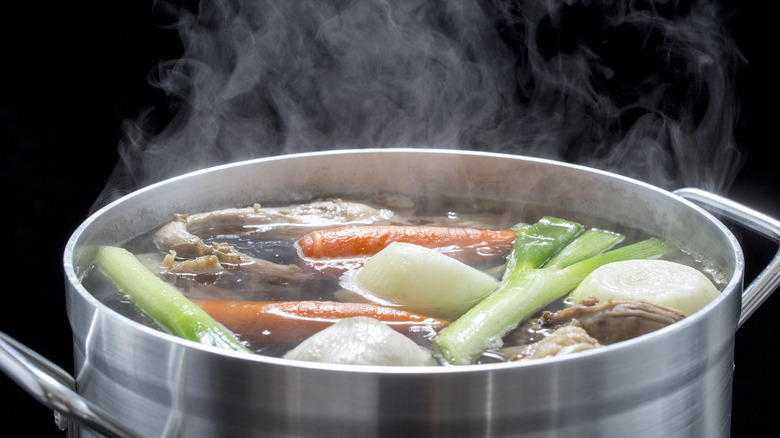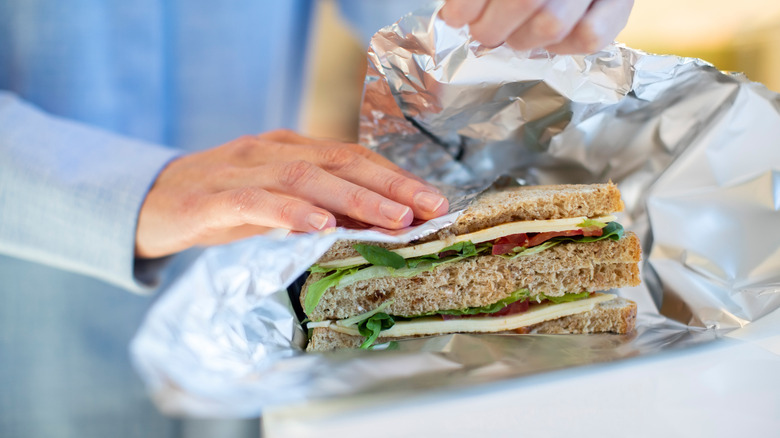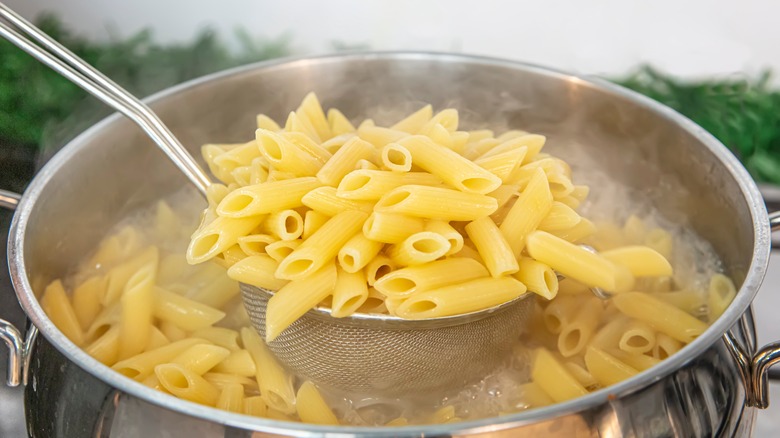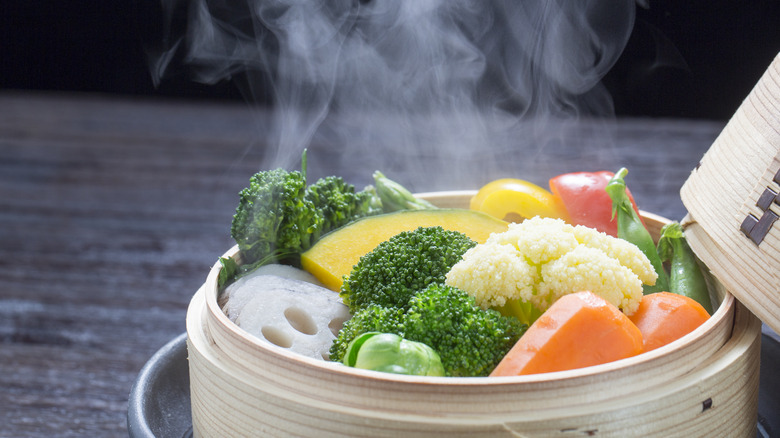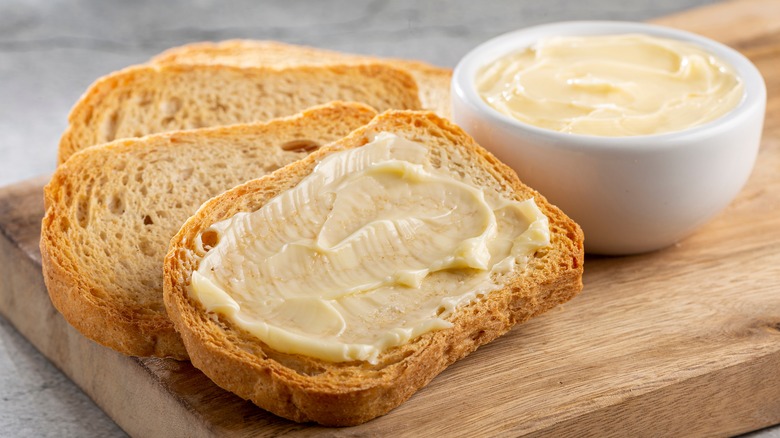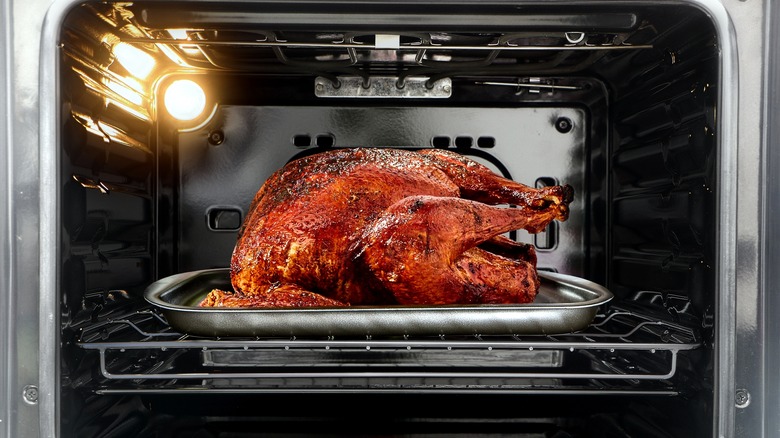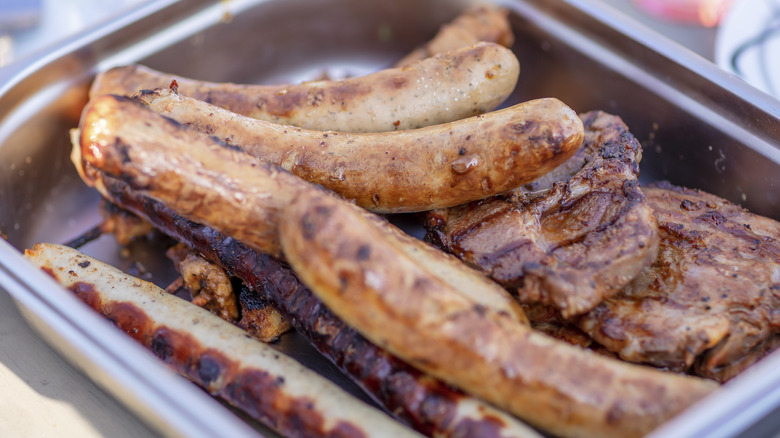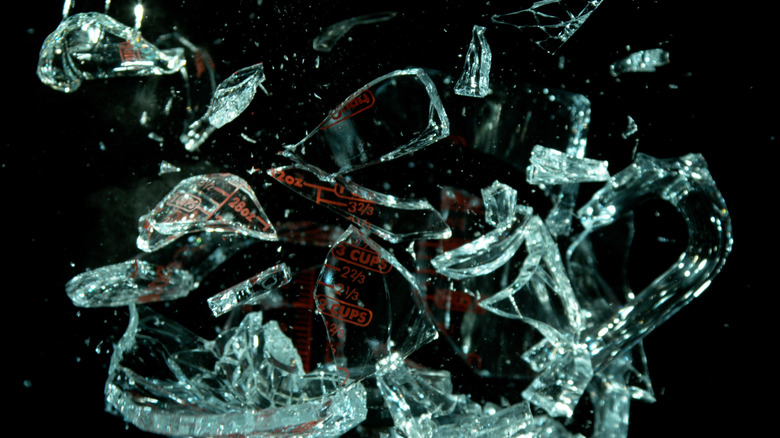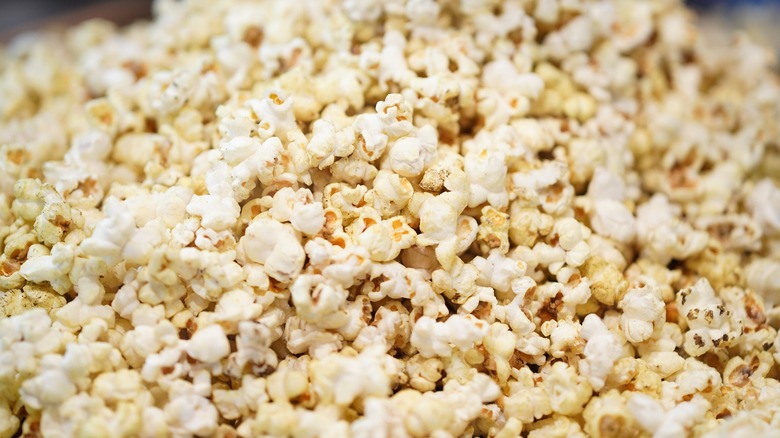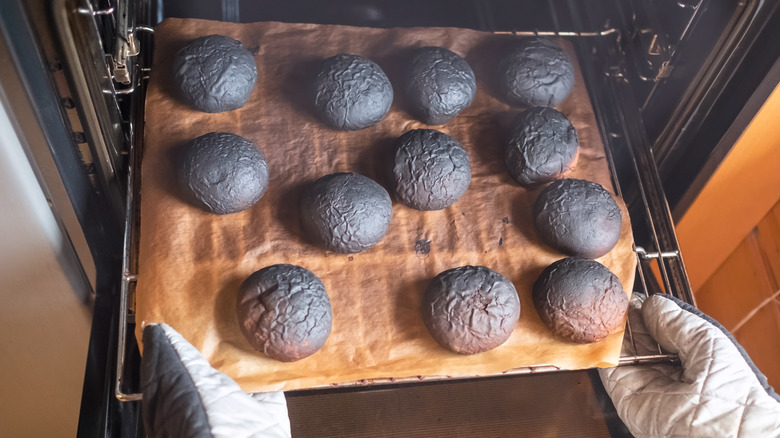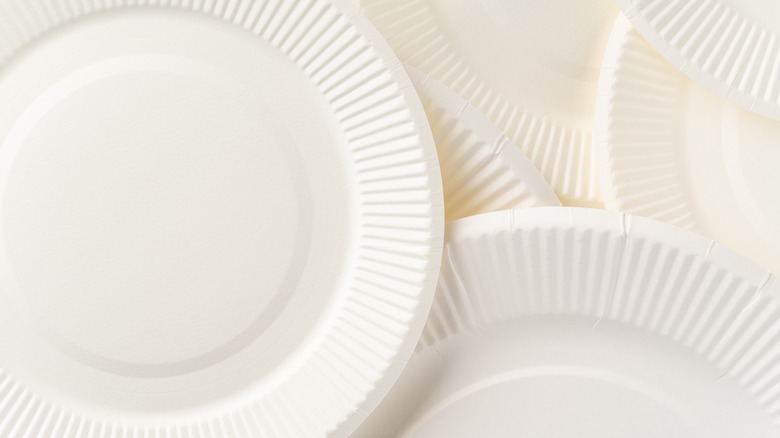12 Foods You Should Never Cook In A Toaster Oven
Toaster ovens are convenient appliances that can, despite their name, go far beyond simple toasting. They can bake, broil, defrost, and reheat without hogging your kitchen countertop real estate. Because of their small size, hot air circulates fast, and the heating elements are located close to the food. This gives them the advantage over regular ovens of quickly using high, direct heat to cook food quickly and efficiently. Toaster ovens are an especially energy-conscious choice for cooking small portions or heating up leftovers without firing up a big oven.
Many kinds of dishes that can be cooked in a regular oven can be cooked in a toaster oven as well. It's up to the task of baking cookies, broiling meat, cooking frozen food, and melting cheesy toppings. You can even make smores in a toaster oven. Just make sure to use smaller-sized bakeware and scale down your recipes.
However, these ovens are not a good choice for certain foods and dishes. The same features that allow them to be quick and efficient can pose safety hazards if used incorrectly. Following some guidelines for which foods to never cook in a toaster oven will prevent you from ruining your food, damaging your oven, or even starting a fire.
Overly greasy foods
While toaster ovens are surprisingly versatile, very fatty or greasy foods should never be cooked inside one for safety reasons. Because these ovens are usually small, the food on the rack will be quite close to the heating elements, which are often exposed. Oily foods are much more prone to splattering or trickling down off the tray, especially once they're hot. If these particles land on the heating coils, there is a serious risk of fire. Fatty foods can also spark a spontaneous grease fire, which can occur when cooking oil gets too hot, reaches its smoke point, and ignites (per ADT).
Since toaster ovens are designed to get very hot quickly, think twice about using it for fatty meats, extra cheesy toppings, or anything drenched in oil. Don't toast bread covered in butter or place a frozen pizza directly on the wire rack. Definitely avoid frying anything inside. According to the U.S. Fire Administration, keep the oven door closed in the event of a fire. Fire needs oxygen to use as fuel, and the closed door will allow the fire to use up the available oxygen and burn itself out. If the flames escape the oven, leave your home and call 911.
Liquid dishes
Avoid putting foods with large amounts of liquid in the toaster oven because watery dishes are at risk of spilling onto the hot heating elements inside the appliance. This can occur if water boils over or splatters while simmering or, despite your best efforts, the dish bumps against the rack or oven wall and spills. Water can damage your toaster oven. More importantly, just like with greasy foods, it can start a fire, so save the soups and spaghetti for the stovetop. Rice is another food to avoid cooking this way. Besides the fact that rice cooks in water, the hot temperatures tend to make the bottom of the rice burn and stick to the pan. An exception? Baked rice dishes like this Arborio rice ball casserole can be baked in a toaster oven because the rice is already cooked before the dish is placed inside.
On the same note, don't reach in and add water to anything that is cooking inside the toaster oven. It's very easy to spill this way. Dry foods are a better bet, but if you cook something with a small amount of water or liquid, make sure to place the dish inside a larger baking dish with high sides to catch any drops that might spill out of the primary pan.
Foods cooked in aluminum foil
When cooking in a toaster oven, it's not just the type of food that's important, but the type of container as well. Since aluminum foil is widely used in traditional ovens, many may assume it's safe for toaster ovens too, but the small size of the latter changes the game. Your safest bet is to read the manual for your appliance and only use the kind of pans and materials the manufacturer recommends. Some manufacturers allow aluminum foil in their toaster ovens and provide instructions for its use, and others prohibit it.
If you do use foil, follow these safety tips. According to Kitchengearoid, trim the foil to the same size as the pan to avoid extra material touching the heating elements or the hot sides of the oven. Any contact can cause the foil to scorch or melt. The foil also behaves like a reflector and increases the temperature even more, and the rising mercury can damage the device or start a fire. For the same reason, don't cover the crumb tray in foil in the hopes of making cleanup easier.
Pasta
Pasta cooks in boiling water, and as we've seen, liquid dishes are a big no-no when it comes to cooking in a toaster oven. It's not worth the risk of the water spilling over and igniting the heating coils. Pasta is also best when cooked in a large quantity of water; that size pot will generally be too big for this diminutive appliance.
While cooking pasta from scratch isn't safe or realistic in a toaster oven, other kinds of pasta dishes are ideal for this device. Baked pasta dishes use pasta that is already cooked, or at least partially cooked, and mixed with sauce, cheese, or other ingredients. These dishes can then be baked in the toaster oven, melding the flavors together and creating a lovely golden brown top. Try baked feta pasta, baked shell pasta with five cheeses, or easy baked spaghetti for cheesy, crispy perfection. As with anything made in a toaster oven, scale down the quantities of the ingredients to accommodate the smaller-sized baking dishes that will fit inside.
Steamed food
Think twice before steaming foods like vegetables, salmon, shrimp, puddings, spring rolls, and dumplings in a toaster oven. It's possible to steam foods in a regular oven, so this point might be confusing, but there are important differences between the two appliances. Steaming in a regular oven requires the food to sit on a rack that is placed in a larger baking dish containing water, and the food is often covered with aluminum foil to keep the steam in. Toaster ovens are much smaller, and large pots are likely to sit very close to the walls and heating elements of the device. Even if you use a mini rack and pan, aluminum foil is problematic because it can spark a fire or cause the toaster oven to overheat.
The water that steaming requires can damage the appliance if it spills or touches the hot coils. Only steam foods in a toaster oven if you're using a special toaster oven built to handle steaming. An exception is using a regular toaster oven to reheat steamed foods that are already cooked.
If you have your heart set on vegetables or fish and you only have a toaster oven available, you can successfully roast these foods instead. Use a smaller pan that fits inside and dress the ingredients with olive oil, salt, and pepper. Don't forget to sprinkle on a little-known ingredient that you can use for crispier roasted vegetables: cornstarch.
Toast
Yes, toast. Despite its name, a toaster oven is not the best choice for actually making toast. You can certainly use a toaster oven if it's the only device available, but it has certain disadvantages over a regular toaster, which is built specifically for toasting bread. For one, toaster ovens take longer. According to Consumer Reports, toaster ovens take one and a half to five minutes longer to toast bread than traditional toasters, depending on the model, while also marking the bread with dark lines from the rack.
A regular toaster will cook toast more evenly. You can make up for this by preheating your toaster oven first. Preheating will also speed up the toasting time, but adding the preheating time is not much of a time saver. It can take up to 10 minutes to preheat a toaster oven to 350 degrees Fahrenheit, and the toast will be ready in four to five minutes (per Bread Guide). Some models only have a single heating element on the top rather than one on the bottom as well, and in this case, you will have to flip your bread over halfway through cooking.
Despite these disadvantages, toaster ovens win when it's a question of quantity over quality. Household toasters usually hold two or four slices of bread at a time, while a toaster oven may fit six or more slices of bread inside. Opt for the latter to lower your chances of serving cold toast to a hungry group.
Large amounts of food
You're cooking for a crowd, and you're using a toaster oven. It might seem like a good idea to use the biggest pot or pan you can get away with and fill it with food. You may even be tempted to place something that doesn't fit in a pan on the wire rack itself. For safety's sake, avoid the urge to cook large amounts of food with this appliance. Filling the oven with more food than it's designed to handle is a fire risk because it will raise the internal temperature excessively.
Placing food close to the heating elements and walls can also spark a fire, so avoid baking big cakes and steer clear of large whole chickens or turkeys. Even if you can fit them inside, if the top of the bird is close to the upper heating element, the animal fat may splatter onto it and ignite a grease fire, and the upper surface of a cake may burn while the inside remains undercooked.
Use baking pans that don't come too close to the sides and top of the toaster oven. You can find mini bakeware, one-quarter or one-eighth-sized baking sheets, and ramekins for single portions of baked goods.
Some meats
Many kinds of meat that can be cooked in a regular oven or on the grill can be cooked in a toaster oven too, but certain kinds of meat are best left to another cooking method. Any kind of splattering from animal fat or grease is a fire hazard, so pass on the bratwurst, for example, as its juices are known to spurt out during cooking. To minimize the spray of oils, don't cook very fatty cuts of meat, pieces without excess fat trimmed off, or meat soaked in wet marinades, and don't fry the meat in oil inside this appliance.
Avoid cooking thick cuts of meat in a toaster oven as well. These ovens are smaller than regular ovens, heat up faster, and get quite hot, especially when using the broil setting. Thick cuts of meat take longer to cook, so choosing thinner cuts allows the oven to run for less time overall and reduces the chance that it will overheat.
Never cook meat sitting directly on the wire rack of a toaster oven. The dripping fat and juices will fall onto the lower heating coils and pose a very serious fire risk, so always contain meat in a baking pan. Some toaster ovens come with a slotted pan or a pan with a rack attached, allowing the drippings to be much more safely contained in the lower pan.
Foods cooked in glass baking dishes
While some companies offer a line of toaster oven-safe glass baking dishes, most products are not designed for this kind of oven. Unless the manufacturer specifically recommends it, don't put glass bakeware in the toaster oven, even if it's marked as safe for regular ovens. The reason is there is a greater chance that the dish will splinter or break. Modern Pyrex, a popular brand of glass baking dishes, is made of soda lime silicate glass that can shatter easily when it undergoes a relatively low change in temperature of 99 degrees Fahrenheit (per Discover Magazine).
Since these smaller ovens heat up so quickly and the food is just inches away from the heat source, toaster ovens reach their intended temperature much more quickly than their regular-sized counterparts. The faster temperature change increases the risk of the glass splintering from thermal shock. Opt for ceramic, metal, or stone baking dishes instead, as they are more likely to remain unaffected by high cooking temperatures.
Popcorn
Popcorn is more suited to an air popper, the microwave, or a traditional skillet, as cooking this snack in a toaster oven runs some risks. While you can get away with cooking some kinds of popcorn in this oven, never use it for cooking a bag of microwave popcorn. The paper bag will puff up and sit dangerously close to, or actually touch, the upper heating coils and the side walls of the appliance, both of which get extremely hot. The paper will be at a high risk of burning or catching on fire (per Kitchen Seer). Use these bags in the microwave only.
According to Thought Co, popcorn pops when the water naturally contained inside the kernels heats up and turns into steam. The build-up of steam puts pressure on the outer shell of the kernel, and when the temperature reaches 135 psi, the shell breaks open, causing the inside of the kernel to spill out and harden into the familiar puffy shape of popcorn.
Toaster ovens heat up more slowly than other popcorn cooking devices, and this additional heating time can cause the kernel to dry out as steam gradually escapes from the tip. Less water will be left inside the kernel, and it might not be enough to create the amount of pressure required to pop each piece, leaving you with incompletely popped kernels or a disappointing bowl of unpopped seeds.
Foods at risk of burning
The high heat and fast heating time of toaster ovens are ideal for quickly warming leftovers and providing those delectable crispy tops on baked dishes. These same qualities make it easy to burn the foods that are cooking inside, especially since the racks are very close to the heating coils. To minimize the risk of ruining your hard work, avoid using the toaster oven for foods that are at a higher risk of burning.
Sugary foods are at the top of the list. Hold the sugary toppings or glazes made from brown sugar, honey, maple syrup, and especially powdered sugar, which is more flammable than other forms of sugar. Sugars will caramelize in the oven, which is certainly desirable, but once the temperature is high enough, they will burn. According to Exploratorium, sugar burns above 350 degrees Fahrenheit, and many foods are cooked at a higher temperature than this. Besides the burning risk, overcooking sugar will give your dish a bitter taste.
Avoid using a toaster oven to cook foods not contained in a baking dish. Any fat, sugar, or crumbs that drip or fall to the bottom and land on the lower heating elements can easily smoke, burn, or catch on fire. Be very careful when baking small or thin foods like nuts, seeds, kale chips, or thinly sliced potato rounds. They can easily fall to the bottom, and their small size means they will burn faster than more substantial foods.
Foods cooked in paper
Heating food on paper plates may seem convenient, just like lining a pan with parchment paper could sound like a good way to save on cleanup, but it's definitely a mistake to put any kind of paper product, including paper towels and cardboard, in the toaster oven. Even though parchment paper is commonly used in regular ovens, many manufacturers of the product warn that it shouldn't be used in a toaster oven. Read the information on the product packaging carefully before considering using it, or avoid using it altogether for safety considerations.
According to Big Time Kitchen, paper products will burn in the range of 424 to 475 degrees Fahrenheit, but even if the temperature is lower, paper is still at a high risk of igniting. Toaster ovens circulate air very quickly, and the heating coils sit close to the food, so any paper that touches the coils or the walls can start a fire, even if the temperature is less than 424 degrees.
Additionally, paper plates can leach toxins into your food when heated, especially if they have a shiny or textured surface or dyes, creating colorful designs.
Parchment paper is also known to discharge dangerous chemicals under high heat (per Eat Pallet). Lining your pan with a little olive oil or butter to prevent sticking is a better choice.
